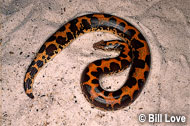Description:
Several specimens can be kept in a 20-gallon terrarium with a bed of loose sand at least 3 or 4 inches thick on the bottom. Hiding places in the form of cork bark or ceramic decorations can be partially buried in the sand. Most specimens spend their time under the sand and seldom will be seen on the surface. The species does well at moderate temperatures (roughly 75 to 85 degrees Fahrenheit) when given an undertank heating pad bringing a third of the terrarium substrate up to 90 to 95 degrees for 12 hours a day. The temperature can be allowed to drop sharply at night, temperatures near 60 degrees are tolerated well. Keep the terrarium dry—a water bowl is not necessary and may be harmful. Instead, soak your specimen in tepid water once a week or every two weeks. A basking light seldom will be used. Large specimens may not like to be handled and can have a painful bite. Feeding is not a problem, as even young specimens will readily take pinky mice, while larger adults can take several large mice in one meal. Feed once or twice a week, but avoid making your specimen too fat. Kenyan sand boas feed best at night, sometimes taking their food by grabbing it from underneath the sand. Captive-bred specimens in several color patterns are widely available today. For more information, read our detailed Kenyan sand boa care sheet.
Habitat:
This is a species of dry habitats, including both deserts and dry grasslands with a minimum of shrubs. It is a nocturnal burrower in areas where rain may not occur on even a yearly basis.
Range:
Kenyan sand boas are widely found across eastern Africa, from the mouth of the Nile in Egypt, south to Kenya and Tanzania.
Scientific Name: Eryx colubrinus
Species Group: boa
Family: Erycinidae
Size: 20 to 24 inches
Level: beginner
Weight:
Dangerous: No



